Luetgenhausen
|
Luetgenhausen
Rhumspringe parish
|
||
|---|---|---|
| Coordinates: 51 ° 36 ′ 15 ″ N , 10 ° 16 ′ 34 ″ E | ||
| Height : | approx. 160 m above sea level NN | |
| Area : | 5.6 km² | |
| Residents : | 190 (2009) | |
| Population density : | 34 inhabitants / km² | |
| Incorporation : | 1st January 1973 | |
| Postal code : | 37434 | |
| Area code : | 05529 | |
|
Location of Lütgenhausen in Lower Saxony |
||
Lütgenhausen is part of the municipality Rhumspringe in the district of Göttingen in Lower Saxony ( Germany ).
geography
Lütgenhausen is located on the Rhume , which also forms the border to the Untereichsfeld and is also protected as part of the Rhumeaue / Ellerniederung / Gillersheimer Bachtal nature reserve , about two kilometers southeast of Wollershausen , 500 meters north of Rüdershausen and a good one kilometer northwest of Rhumspringe.
history
In 1776 , after preliminary work by Heinrich Christian Körtje , Benjamin Hase created a plan for the relocation of the village of Lutgenhausen an der Rhume (south of Herzberg) , which was copied by the chief architect Friedrich Wilhelm Böttcher . The background was the proximity of the place to the Rhume and the associated floods; the place, which then consisted of 32 houses, was then completely demolished in 1782 and moved to a higher location. When it was first mentioned is unclear, but there is a document from 1391. In this document, the place is listed under the name Lütgen Rüdershausen and it is stated that Duke Ernst von Braunschweig and his brother Friedrich their shares in the village of Lütgen Rodershusen the prelate of Pöhlde , Hermann of Sulingen. sold. Before the sale, the village was under the sovereignty of the Mainz office of Gieboldehausen . With the establishment of the Kingdom of Westphalia , Lütgenhaus's affiliation was also restructured. From 1807 it became part of the Harz Department , to which the Duderstadt district was subordinate. As a member of the canton of Gieboldehausens, the Lutheran church village of Lütgenhausen had a total of 190 inhabitants, who were spread over 21 houses. After the dissolution of the Kingdom of Westphalia, the place was part of the Herzberg district. The population rose to 232 people around the middle of the 19th century, and the number of houses also increased to 38. As part of the municipal territorial reform in Lower Saxony on January 1, 1973, Lütgenhausen was assigned to the Göttingen district (previously Osterode am Harz ) and to the Rhumspringe municipality incorporated.
coat of arms
| Blazon : “Split between blue and red; in front half a silver (white) gold (yellow) armored eagle at the gap; behind a half silver (white) lily at the gap. " | |
| Justification of the coat of arms: The half eagle goes back to a coat of arms of the first rifle club from the 18th century. The silver lily is an attribute of the Virgin Mary, under whose patronage the Wollershausen Church, to which the community belonged, is. |
literature
- Annemarie Gropengießer: The church registers of Wollershausen 1644 to 1910. Local family register of Lütgenhausen and Wollershausen . Parish of Sankt-Marien Wollershausen, Gieboldehausen 2005.
Individual evidence
- ^ Publications of the Lower Saxony archive administration: supplement, issues 16-22 , Vandenhoeck and Ruprecht, 1972, p. 65; Preview over google books
- ^ Johann Georg Heinrich Hassel: Statistical Repertory on the Kingdom of Westphalia . Vieweg, Braunschweig 1813, p. 16 .
- ↑ Friedrich Wilhelm Harseim, C. Schlüter: Statistical Manual for the Kingdom of Hanover . Ed .: Friedrich Wilhelm Harseim, C. Schlüter. Schlütersche Hofbuchdruckerei, Hanover 1848, p. 82 .
- ^ Federal Statistical Office (ed.): Historical municipality directory for the Federal Republic of Germany. Name, border and key number changes in municipalities, counties and administrative districts from May 27, 1970 to December 31, 1982 . W. Kohlhammer GmbH, Stuttgart and Mainz 1983, ISBN 3-17-003263-1 , p. 206 .
- ↑ Lütgenhausen town portrait



